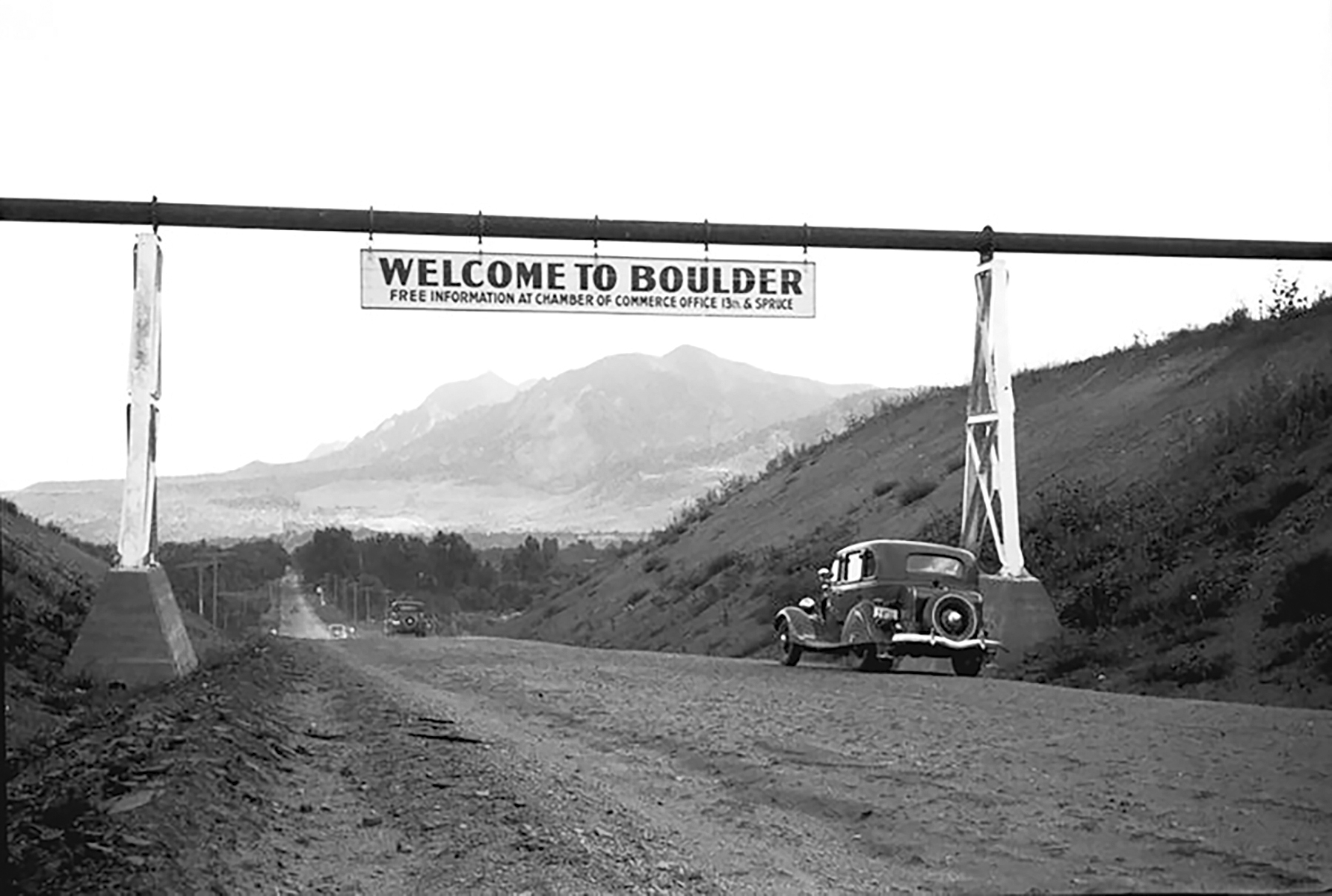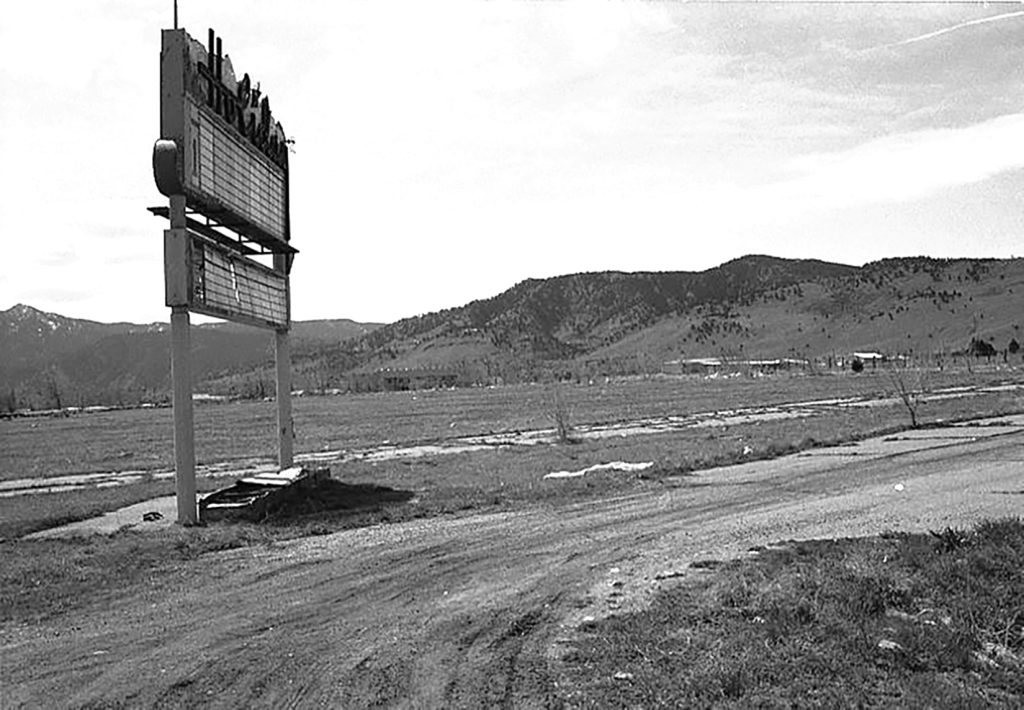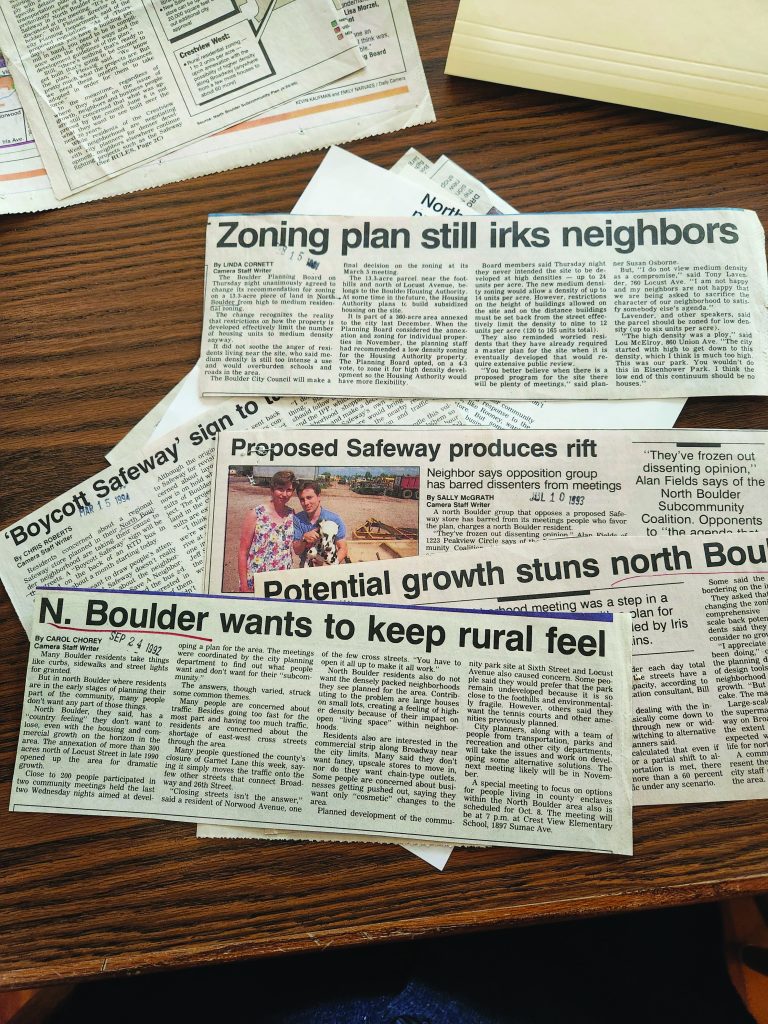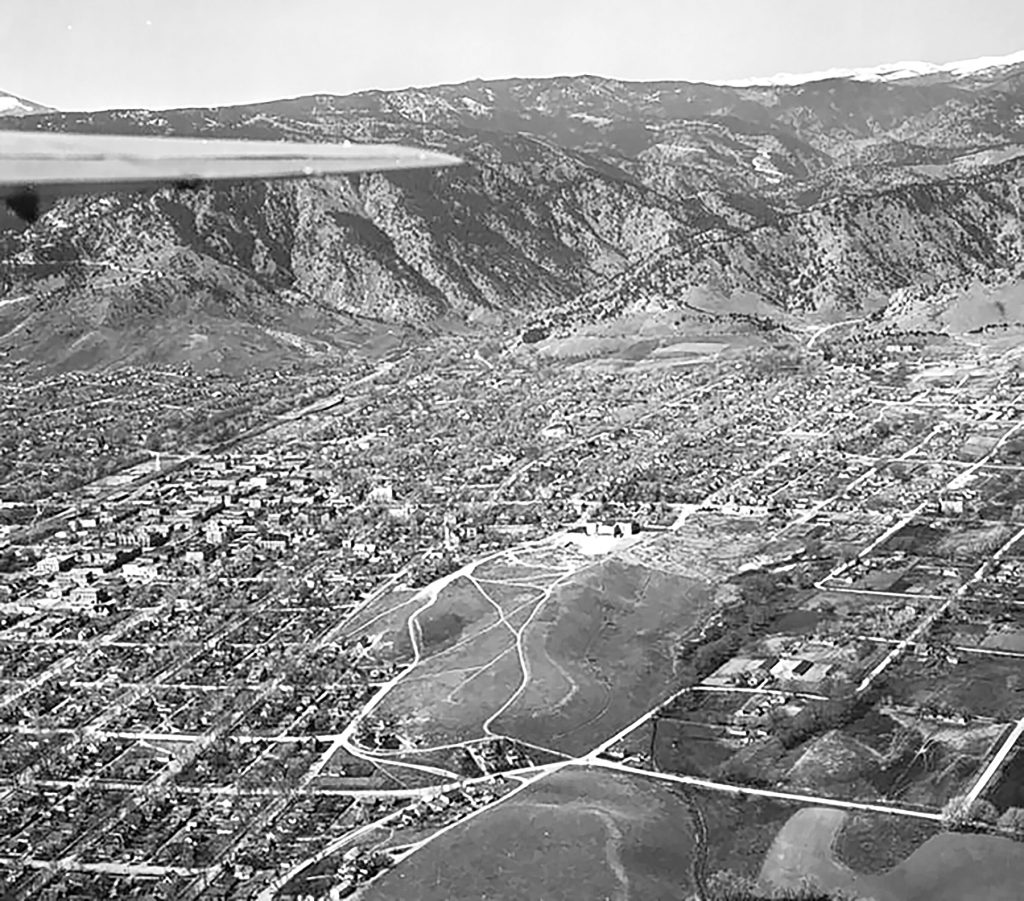
“Boulder’s last frontier,” declared a 1985 article in the Daily Camera’s Sunday Focus magazine. It was a multi-page spread all about what we know today as North Boulder: dozens of stories and photos detailing the “rural” and “free-wheeling spirit” of this “world within a world.”
The area along North Broadway, from Iris Avenue to U.S. 36, was “a realm of contrasts and contradictions,” reporter Kurt Chandler wrote, “intimate yet secretive, often coarse, sometimes refined, and never predictable.”
North Boulder of yesteryear was filled with the strange and unusual. The Bustop, a strip club, sat next to an RV storage facility/massage parlor called The Flamingo. Colorado National Guard troops worked on a seven-acre active Army base. The roads were unpaved, backyards full of donkeys, rabbits, roosters and all manners of livestock.
Today, the Army base is a just-completed apartment complex. The Bus Stop is now affordable rentals. Farms and fields are mostly gone, at least on the west side of 36, and the homes being built at Jay and 26th, reported as costing $80,000 at the time of the ’85 article, are now worth 10 times that.
Perhaps no neighborhood represents the metamorphosis of Boulder better than its northern edge. Even its geographic boundaries are fluid: Twenty years ago, North Boulder was the area surrounding North Boulder Park and the Ideal Marketplace, near the old hospital on Broadway between Alpine and Balsam. Now, that’s Old North Boulder. Today’s North Boulder used to be called North North Boulder or, sometimes, The Dogpatch.
The evolution is not complete. A long-promised library branch will open later this year. Trailers at one of the area’s two mobile home parks are slowly being replaced with fixed-foundation, ultra-environmentally friendly homes. The Boulder Museum of Contemporary Art (BMoCA) hopes to relocate to NoBo, anchoring what will become a 100,000-square-foot cultural campus. Even more housing is in the works along Broadway, and there’s potential for development across U.S. 36 to the north and east as Boulder looks to activate its 500-acre planning reserve.
Through it all, North Boulder has been able to retain some of the gritty, independent spirit of days gone by, even as residents embrace change in a way other parts of Boulder traditionally haven’t.
“It’s growing and evolving on a daily basis,” says Aaron Brockett, Boulder’s mayor and proud North Boulder resident. “Think of a kaleidoscope: There’s always some beautiful pattern, then you move it around, and there’s something new and different.”

‘Dream of decades’
For a microcosm of Boulder’s transformation over the years, consider the Holiday neighborhood. It began life in 1953 as the Holiday Drive-in Theater. In 1969, the drive-in moved from its original home at 28th and Colorado, traveling four miles up U.S. 36 to Lee Hill Road. The first film to play at the new location was Easy Rider; today, a street in the neighborhood is named after it.
The drive-in closed in the 1980s, according to various Daily Camera accounts, and the field — still dotted with speakers mounted on car-window height wooden posts — sat fallow until the early 2000s when it became the mixed-use Holiday neighborhood. Nonprofit housing authority Boulder Housing Partners orchestrated the redevelopment; Holiday has among the highest concentrations of rent-capped units in the city.
While the former drive-in was still an empty lot, a young couple from Connecticut, visiting family in Cheyenne, took their one spare day and drove down to Boulder to learn about a planned co-housing community that would become Wild Sage. They attended a meeting and did some research before deciding to buy a house not only sight unseen, but unbuilt.
The family was Brockett’s. Today, he is one of North Boulder’s biggest cheerleaders.
“It’s not a place that’s static,” Brockett says. “There are lots of people walking their dogs and such, people are generally friendly and happy to meet each other. We have a lot of lovely third places” — spaces that aren’t work or home where people gather, like coffee shops, parks and public plazas.

He’s looking forward to one more third place: the North Boulder library, on track for a June opening. It will be that community’s “first public building,” according to library director David Farnan.
A northern branch has been discussed since the City started planning for NoBo’s future in the late 1980s. “It’s the dream of decades,” Brockett says. “Part of my plan for my retirement years is to walk over there on a regular basis and grab the newspaper off the shelf. I am looking forward to spending a lot of time in that branch.”
Demand for library services has always been high in North Boulder, Farnan says. A corner library has been operational since 2014, occupying just 576 square feet at 4600 Broadway.
“When we opened in 2014,” Farnan wrote via email, “the community literally checked out all of the books in less than a week. We bought more, and the community cleaned them out a second time. It took us a month or two before we found the right balance.”
‘Renegade spirit’
Other public amenities will soon enhance NoBo’s offerings. The 3.5-mile bike, hike and horse-friendly North Sky Trail connecting Foothills Park to Joder Ranch will open this year. Violet Park, now an overgrown field, will become Boulder’s newest neighborhood park in 2025.
The most ambitious plan is for the aforementioned creative campus, future home to BMoCA. As Boulder’s official arts district, it was important that the area be anchored by “a cultural institution,” says Andrew Ghadimi, something that wasn’t “commercially driven.”
Ghadimi was part of a group of property and business owners pushing the idea of a business improvement district before the pandemic made the idea of more property taxes unpalatable. He owns the site where the cultural campus will go — and “about 40% of the land on the west side of Broadway,” which “hasn’t transformed at the same pace as the city.”
That means Ghadimi may have more say over the future of North Boulder than any other individual. Preservation is top of mind: He envisions incorporating Carniceria La Zacatecana at 4483 Broadway into the new cultural campus.
“It’s the only market that far up in the neighborhood,” he says. “And it also caters to the Latinx community. NoBo has the largest population of Latinx [people] in Boulder.” East of Broadway, from Lee Hill Drive to Iris Ave, one-quarter of residents are Hispanic, according to census data.
He also wants to save the warehouses at the northernmost end of Broadway, where his business’ offices are. As available industrial space has been redeveloped and rents are pushed higher, the area — dubbed Emerald City by tenants, after Ghadimi’s property management company — has become a hub for artists and the creative community.
Art gallery The Crowd Collective rents there. So does the Boulder Metalsmithing Association. Drum Mountain and The Photo Center have spaces there; they teach music and photography, respectively. Atrévete, an upcycled and recycled clothing brand, and outdoor gear consignment shop Boulder Sports Recycler are mere steps away from each other.
“That is the heart of the arts community,” Ghadimi says. “I really appreciate the informal nature that North Boulder still has, a close-knit community of kooky people that want to do something weird.
“There’s this weird renegade spirit that has kind of been preserved.”

‘A little messy’
North Boulder’s legacy of rebellion is well documented. In the mid-60s, county residents attempted to form their own city consisting of 4,500 acres north of Jay Road, according to archival Camera coverage. In the 1990s, endless headlines were generated during a yearslong battle to create Boulder’s first subcommunity plan. It has guided development there ever since.
“There are people who were on council then who hate North Boulder to this day,” says Lisa Morzel. She was in the thick of citizen efforts to shape the plan, advocacy that led to her own decade-spanning stint on City Council.
Morzel recalls the early days of the plan: “People were out with pitchforks: ‘We don’t want the city, we don’t want your streetlights, we don’t want your codes, we don’t want anything.’ The City came up and [tried] to city-fy us. We would just scream them down.”
Pushback to today’s development has been quieter. The library went in without much of a fight (although some immediate neighbors weren’t happy). Although it’s still early, BMoCA has received overwhelmingly positive feedback so far, according to deputy director Gwen Burak.
The creative campus “is creating essentially a more walkable neighborhood by adding all these amenities,” Burak theorizes, possibly forestalling opposition. Ghadimi believes the difference is what people are fighting for.
“I often think, what are people trying to preserve? And it’s the value of their single-family home,” he says. “In North Boulder, you have this group of small business [owners] that don’t even live in Boulder. A lot of the art tenants came to Boulder because of this collective of friends and artists.
“That’s what they’re trying to preserve, in a way that I think other parts of town maybe gave up on.”
Those qualities of community and collaboration, along with Ghadimi’s vision, are what drew BMoCA to the area. The museum has rented 1750 13th St. from the City of Boulder for 48 years. The $1 per year lease is a great deal, financially, but the historic building limits the type of art BMoCA can bring in.
“There’s some realness” to North Boulder, Burak says. “It’s a little more organic, and not in the big-O Boulder way. You see less buttoned-up stuff up there” than in other parts of Boulder.
“It’s a little messy, and an arts museum should be in the messy.”
‘By and for the community’
As in years past, the “messiest” parts of North Boulder aren’t technically in Boulder — Emerald City sits on county land. Ghadimi would like to be added into city limits so he can access municipal water.
“We’re on a septic system, and we have to truck in water,” he says. “I can’t plant trees because there’s no water” to keep them alive.
The City wants him to annex, too, but building out the necessary infrastructure costs money: in this case, more than $3 million, Ghadimi says. As the landowner, he would have to foot the bill.
“I don’t just have $3 million,” he says. “I would have to increase rents. It’s this really confusing thing where we’re trying to help the community but we make it harder for the community to stay there. What’s the point of building things that no one can afford?”
Although he hopes to see Broadway “fill in over time” with more services for residents, Mayor Brockett wants the industrial buildings to remain. He believes there’s a case for the “older, low-cost” spaces to qualify as a community benefit, one of the requirements for annexation.
“They’re lovely creative spaces,” he says. “They provide a real service to the community that we don’t have in other places in town.”
For his part, Ghadimi says he is committed to keeping North Boulder “by and for the community.” He’s bringing back Wapo’s Mexican restaurant, closed since a devastating kitchen fire in 2022. He has kept a pre-pandemic townhome project alive and intends to include studio and housing for artists in the creative campus.
“It’s the community that gave us our start,” he says. “We owe it to them.”

